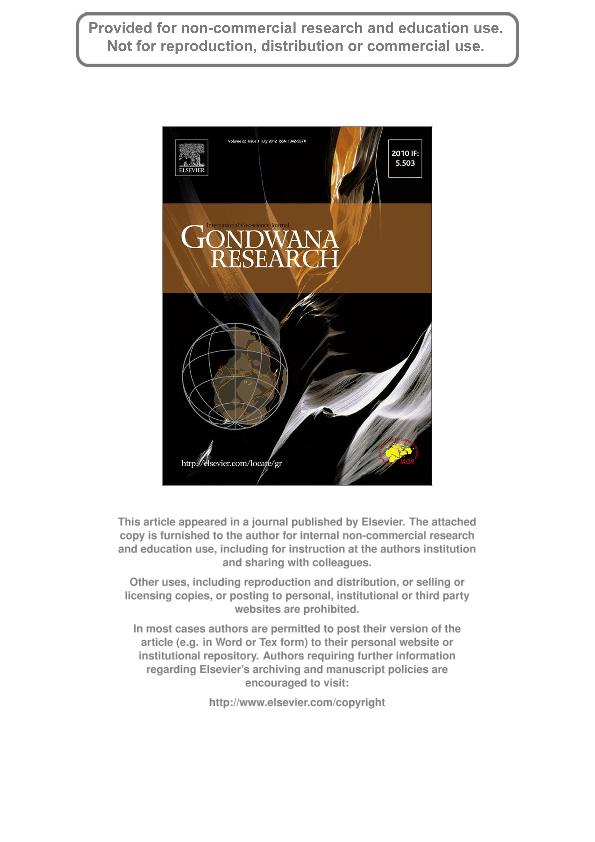Artículo
Glacial paradoxes during the late Paleozoic ice age: Evaluating the equilibrium line altitude as a control on glaciation
Isbell, John L.; Henry, Lindsey C.; Gulbranson, Erik L.; Limarino, Carlos Oscar ; Fraiser, Margaret L.; Koch, Zelenda J.; Ciccioli, Patricia Lucia
; Fraiser, Margaret L.; Koch, Zelenda J.; Ciccioli, Patricia Lucia ; Dineen, Ashley A.
; Dineen, Ashley A.
 ; Fraiser, Margaret L.; Koch, Zelenda J.; Ciccioli, Patricia Lucia
; Fraiser, Margaret L.; Koch, Zelenda J.; Ciccioli, Patricia Lucia ; Dineen, Ashley A.
; Dineen, Ashley A.
Fecha de publicación:
07/2012
Editorial:
Elsevier Science
Revista:
Gondwana Research
ISSN:
1342-937X
Idioma:
Inglés
Tipo de recurso:
Artículo publicado
Clasificación temática:
Resumen
The late Paleozoic ice age (LPIA) consists of multiple glaciations that waxed and waned across Gondwana during the Carboniferous and Permian. Three key intervals are evaluated using the concept of the equilibrium-line altitude (ELA) as a control on glaciation to provide insight into two intervals of paradoxical ice distribution during and following glaciation. The LPIA began in the mid-latitudes during the Viséan in western Argentina with the growth of glaciers in the Protoprecordillera. Glaciation was initiated by uplift of the range above the ELA. In the Bashkirian, deglaciation occurred there while glaciation was beginning at the same latitude in uplands associated with the Paraná Basin in Brazil. Analysis suggests that deglaciation of the Protoprecordillera occurred due to extensional collapse of the range below the ELA during a westward shift in the location of plate subduction. During Late Pennsylvanian-Early Permian peak glaciation for the LPIA, extensive glacimarine deposits indicate that glaciers reached sea level, which corresponds to a major lowering of the ELA due to global cooling. Finally, during the Early to early Late transition out of the LPIA, polar Gondwana was unglaciated. However, three glacial intervals occurred at mid- to high-latitudes in eastern Australia from the Sakmarian to the Capitanian/earliest Wuchiapingian. The magnitude of global cooling during these events is debatable as evidence indicates ice-free conditions and an elevated ELA at the South Pole in Antarctica. This suggests that severe global cooling was not the cause of the final three Australian glaciations, but rather that ELA-related conditions specific to eastern Australia drove these late-phase events. Possible causes for the Australian glaciations include: 1) anomalous cold conditions produced by coastal upwelling, 2) the presence of uplands allowing nucleation of glaciers, 3) fluctuations in pCO 2 levels, and 4) increased precipitation due to the location of the area in the subpolar low pressure belt.
Archivos asociados
Licencia
Identificadores
Colecciones
Articulos(OCA CIUDAD UNIVERSITARIA)
Articulos de OFICINA DE COORDINACION ADMINISTRATIVA CIUDAD UNIVERSITARIA
Articulos de OFICINA DE COORDINACION ADMINISTRATIVA CIUDAD UNIVERSITARIA
Citación
Isbell, John L.; Henry, Lindsey C.; Gulbranson, Erik L.; Limarino, Carlos Oscar; Fraiser, Margaret L.; et al.; Glacial paradoxes during the late Paleozoic ice age: Evaluating the equilibrium line altitude as a control on glaciation; Elsevier Science; Gondwana Research; 22; 1; 7-2012; 1-19
Compartir
Altmétricas



